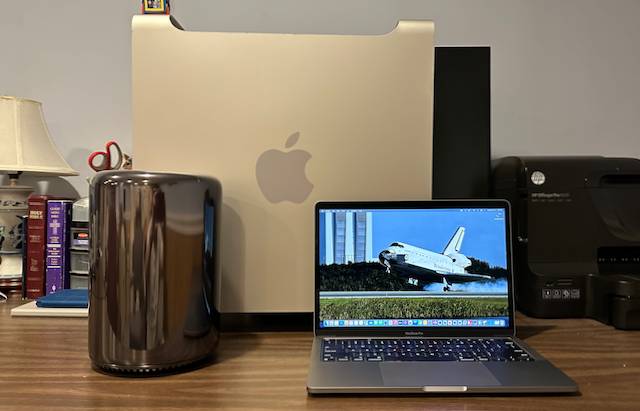
In the summer of 2013, at that year’s Worldwide Developers Conference, Apple executive, Phil Schiller, previewed the then all-new Mac Pro that would go on sale in December of that year. The boxy “Cheese Grater” design was swept away and a new sexy Space Grey polished aluminum housing for its cylindrical body was ushered in.
While looking at old computers on eBay, I came across several 9-year-old Mac Pro towers at a fraction of their retail cost. Most were B stock equipment. Banged up, scratched, and for some of the used computers, broken USB ports. I started watching several of them, getting outbid on many of them. On eBay, $200 looks like a great price, until the final few minutes where the real bidding happens. Eventually, I was able to find a Mac Pro with all of it’s ports working and in good condition. I received my new to me Mac Pro earlier this month.

The 2013 Mac Pro was a radical departure from previous models in the Mac Pro line. Stripped of all of the internal expansion bays, the 2013 was reduced to the essence of the computer: CPU, memory, disk, video, and networking. For everything else, users would have to connect external wired peripherals. Unlike the front-to-back air flow of the physically larger Mac Pro towers, nicknamed “Cheese Graters”, the cylindrical “Trash Can” Mac Pro relied on a triangular system board arrangement that radiated heat into the core of the machine to be drawn up and out the top by a single large fan. The 2013 Mac Pro runs dead silent unless pushed very hard. The only way I know that it is turned on is because the monitor wakes up when I tap the space bar on my keyboard.
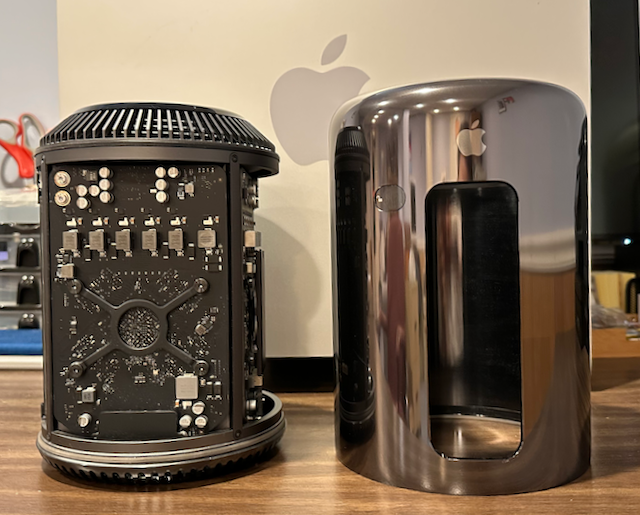
The 2013 Mac Pro went on sale for online orders starting on December 19, 2013. The base model Mac Pro shipped with a single quad-core 3.7GHz Intel Xeon E5 CPU, 12GB of ECC DDR3, dual AMD FirePro 300 GPUs, and 256GB of SSD storage. Six Thunderbolt 2 and four USB-A 3.0 ports round out peripheral connections. The external expansion ports being intended to take on the load of the internal card slots of earlier Mac Pro systems. The Mac Pro also includes dual 10Gbps Ethernet RJ-45 NIC ports for high-speed networking to things like network attacked NAS storage arrays. The base model retailed for $2,999 with a six-core configuration selling for $3,999. Unlike most other products, the 2013 Mac Pro was both designed and built in the United States. A trend, in my opinion, that I would like to see more of in the future now that the CHIPS and Science Act of 2022 has been signed into law.
The 2013 Mac Pro originally shipped with Mac OS 10.9 Mavericks. While it would have been nice for Mac Pro owners if Apple chose to release 2022’s Mac OS 13 Venture for the Mac Pro, Mac OS 12 Monterey will be the last official upgrade for the 2013 Mac Pro.
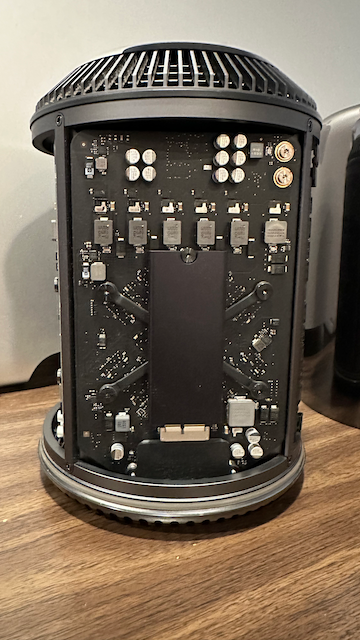
My 2013 Mac Pro has a slightly different configuration that I cannot fully account for. It arrived with the stock quad-core E5 Xeon CPU, and it still has its OEM 1TB SSD. However, the machine only had 8GB (2 x 4GB) of non-OEM non-ECC RAM. The DIMMS in my Mac were matte black and locked like stock RAM, but they weren’t. For high-end use cases, like those the Mac Pro is intended for, Error Correcting Code (ECC) memory should be used due to its ability to detect and correct minor data errors that can lead to data integrity problems and file corruption. I decided to purchase and install an OWC 32GB (2 x 16GB) RAM upgrade kit using DDR3 ECC-R 1866GHz RAM. The OWC upgrade kit was about $60 USD. Apple has a KB article on the 2013 Mac Pro memory specifications if you want to choose a different memory vendor.
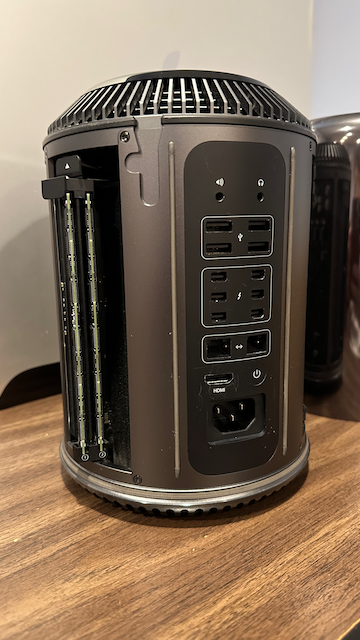
Since I plan on using my Mac Pro, with its 3.7GHz Xeon CPU for running my Intel-based VMware Fusion (aka Workstation in PC parlance) virtual machines. 32GB of RAM should be fine for this use case. If I need more RAM, I can add another 32GB upgrade kit and install the modules into the remaining two memory slots. If you want to tinker with a 2013 Mac Pro of your own, you are in good luck. It is possible to upgrade the Intel Xeon CPU, SSD via an adapter bridge board, and the aforementioned RAM. For an extensive list of hardware and software upgrades that can be performed on the 2013 Mac Pro, also known as MacPro6,1 (Late 2013), check out Greg Gant’s excellent upgrade guide.
The Mac Pro launch was greeted with fanfare from hungry professional customers who had been worried that the Apple was about to abandon the high-end workstation market and focus solely on consumer hardware, like the iMac. However, once the new Mac Pro started shipping to customers things started to turn bad for Apple and customers alike. Apple, in a rare misstep, chose to build the 2013 Mac Pro around dual AMD FirePro video cards. While this configuration worked well for Apple software, like video editing Final Cut Pro, third-party software needed to be updated to support dual video cards. The rest of the industry, focused on single powerful GPU cards.
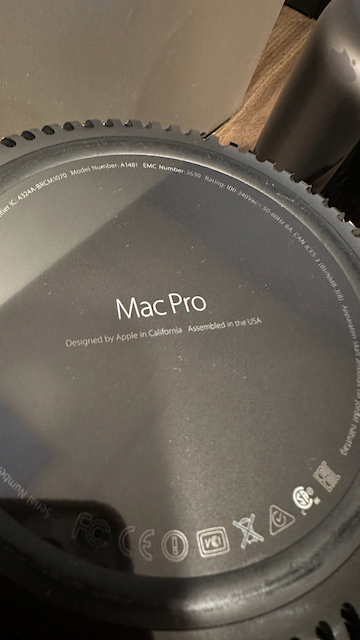
Apple needed to face the fact that they were not going to be able to upgrade the GPU support in the 2013 case design. The dual GPU bet not paying off resulted in four years of not being able to deliver any significant system upgrades, resulting in the 2017 Mac Roundtable discussion with a small number of tech journalists. During that meeting, Apple executives talked about their plans to completely revamp the professional’s Macintosh by returning to a modular design with an Apple external monitor, reversing a decision to cancel the Cinema Display line of first-party monitors.
It would be another two years before Apple introduced the 2019 Intel-based Mac Pro desktop computer and Apple Pro Display XDR. The 2019 Mac Pro was everything that professionals wanted – a large Cheese Grater design that they could stuff full of disk drives, RAM modules, and expansion cards. Everything they wanted, except maybe, the $5,999 starting price. Anyone seriously considering the 2019 Mac Pro would almost certainly want to bump up some of the base model specs, pushing the price of the machine well beyond the starting price. And that was before considering the purchase of the $4,999 Pro Display XDR monitor with Pro Stand, a $999 option.
Today, the complicated Mac Pro story continues as the Mac Pro is one of two remaining Apple computer that have not yet made the transition to the in-house designed M-series Apple Silicon ARM-based CPU designs. In my option, 2022’s Mac Studio and Studio Display was meant as a partial stopgap release for a heavily rumored 2023 Apple Silicon rumored Mac Pro. That has left customers and fans to wonder if the next Mac Pro will be another Cheese Grater like the 2019 model, a compact Mac Studio design, or something else entirely. While I would like to see another “big iron” Cheese Grater design myself, I feel that we are going to end up with something more like the Mac Pro, with limited to no internal card slots and locked down RAM and primary storage like we have seen with M1 and M2-based Mac configurations.
For now, I am happy to have gotten a 2013 Mac Pro. It has an innovative design that will be an interesting talking point in a collection of boxy Macs from yesteryear. And, while Apple may no longer be supporting the 2013 Mac Pro hardware or releasing new versions of Mac OS for it, my new Mac Pro has a long second life ahead of it running my Windows virtual machines. Nice.